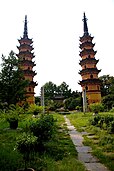Talk:Twin Pagodas (Suzhou)
Appearance
A fact from Twin Pagodas (Suzhou) appeared on Wikipedia's Main Page in the Did you know column on 20 October 2021 (check views). The text of the entry was as follows:
|  |
| This article is rated Start-class on Wikipedia's content assessment scale. It is of interest to the following WikiProjects: | |||||||||||
| |||||||||||
Did you know nomination
[edit]- The following is an archived discussion of the DYK nomination of the article below. Please do not modify this page. Subsequent comments should be made on the appropriate discussion page (such as this nomination's talk page, the article's talk page or Wikipedia talk:Did you know), unless there is consensus to re-open the discussion at this page. No further edits should be made to this page.
The result was: promoted by Theleekycauldron (talk) 05:34, 10 October 2021 (UTC)
( )
- ... that the Twin Pagodas of Suzhou (pictured) have been compared to ink brushes? According to an intellectual joke ... the Twin Pagodas represented brushes, but without an inkstone. The people interpreted the square black Wenchang Tower as such an inkstone... Kögel, Eduard (2015). The Grand Documentation: Ernst Boerschmann and Chinese Religious Architecture. Walter de Gruyter GmbH & Co KG. pp. 191–193. ISBN 9783110401349.
- ALT1:... that only the Twin Pagodas (pictured) remain of the Tang-era Buddhist temple in Suzhou? Behind [the pagodas] stone remains - columns, plinths and decapitated statues - mark the site of the Tang-dynasty temple which existed here until it was burned down in 1860 Courtauld, Caroline; Holdsworth, May (1988). Nanjing, Wuxi, Suzhou and Jiangsu Province : land of lakes and classical gardens. Lincolnwood, Ill., U.S.A. : Passport Books. p. 139.
- Reviewed: Template:Did you know nominations/Yinshu
Created by Alaexis (talk). Self-nominated at 14:58, 17 September 2021 (UTC).
 This article is new enough and long enough. The image is suitably licensed, the hook facts are cited inline and either hook could be used, the article is neutral, and I detected no copyright issues. A QPQ has been done. Cwmhiraeth (talk) 18:57, 24 September 2021 (UTC)
This article is new enough and long enough. The image is suitably licensed, the hook facts are cited inline and either hook could be used, the article is neutral, and I detected no copyright issues. A QPQ has been done. Cwmhiraeth (talk) 18:57, 24 September 2021 (UTC)
.

